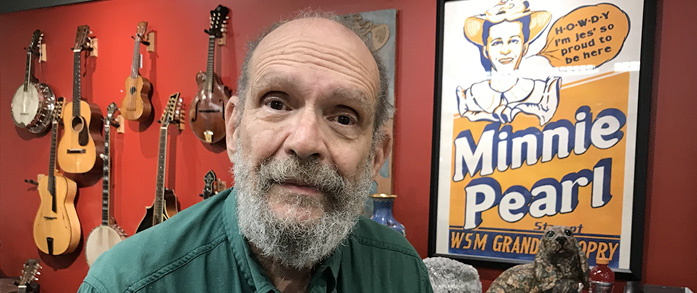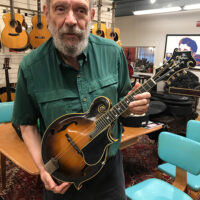
George Gruhn at Gruhn Guitars – photo © Alan Goforth
This set of reflections on bluegrass from George Gruhn is a contribution from Alan Goforth, a professional journalist, author, and aspiring screenwriter in suburban Kansas City. He writes about music regularly, including covering the annual Folk Alliance International conference. He earned a master’s degree from the Missouri School of Journalism.
Bill Monroe did more than create a new musical style when he introduced bluegrass. He also touched off a lively discussion that continues today. Although musicians and fans know bluegrass when they hear it, asking them to define it can generate a range of responses.
“The simple way to define bluegrass is to look at the template that Bill Monroe laid out with his band – Earl Scruggs on the five-string banjo, Lester Flatt playing guitar and singing, Bill Monroe playing mandolin and singing harmony, Chubby Wise playing fiddle, and Howard Watts on bass,” said Jeff Burke, general manager of The Station Inn in Nashville. “You hear all kinds of influences in Monroe’s music, including Scottish, Irish, and blues. I don’t know if he called it bluegrass because Kentucky is the Bluegrass State or because he knew how much blues was in it.”
However, the instruments alone do not define bluegrass, said George Gruhn, chairman and CEO of Gruhn Guitars in Nashville. “The instrumentation typically does include mandolin, five-string banjo, guitar, bass, and fiddle, and it may or may not include a dobro,” he said. “But you can play the same instruments as Bill Monroe and the Bluegrass Boys and not be bluegrass.”
The musical beat provides a clue.
“Old-timey and bluegrass are played differently,” he said. “Bluegrass is played on the offbeat. The rhythmic pattern is distinctly different from old-timey. A good number of blues notes are thrown in, and there are lots of solos. There is singing with the band doing backup. There is a lot of improvisation, but that’s true of old-timey as well.”
“Bluegrass and old-timey are as different as baroque is from Beethoven. It’s not the same, and just because you use those instruments does not make it bluegrass. You can do it in country music, and you can do it in rock music. There are folks who use that instrumentation and do things that are distinctly not bluegrass.”
Gruhn agrees with Burke that the blues influenced Monroe and the birth of bluegrass.
“Defining bluegrass may not be the easiest thing to do, but it definitely has blues notes in it,” he said. “Bluegrass typically uses a blues scale and a blues beat, and the way it’s played has that ornamentation. Bill Monroe was influenced by black blues and he admitted that. It has that certain flavor.”
Bluegrass also is recognizable by the way in which vocals interact with instruments.
“They are not doing a verse and then an instrumental — they are just singing along with the music,” Gruhn said. “That’s something you see with bluegrass. When they sing, that’s a vocal break, and the rest of the band is doing lead stuff while you’re doing that. They back off and are playing backup to the singer. Then they do instrumentals, and each one does instrumental pyrotechnics, which the old-timeys don’t do. Bluegrass is a distinctly different form of music.”
At the same time Monroe was putting his stamp on the mandolin, Earl Scruggs and others were defining bluegrass banjo.
“Snuffy Jenkins influenced Earl Scruggs and Don Reno to do three-finger picking,” he said. “If Don had not gone into the Army, it is likely that he would be the one who became famous, because he and Earl had similar styles. Buit when he got out of the Army, Earl already was well-established. Don didn’t want to be seen as an Earl clone, so he came up with a completely new style of his own. Technically, he was a more sophisticated musician than Earl ever was.”
Monroe combined the mandolin, finger picking, and other sounds to create bluegrass.
“Bill had that sound in mind and was playing those chopped chords,” Gruhn said. “When he got onto the Opry, he wasn’t playing bluegrass. The very first show was in August 1945 when he introduced bluegrass with Earl and Lester, and it was completely different music than it had been even weeks before. That’s what bluegrass is. So it actually is definable. It’s not this nebulous concept.”
In the end, however, Gruhn, like other serious musicians and fans, knows that simply enjoying bluegrass is far more important than attempting to pin down its definition.
“I was born on August 21, 1945, which was about the time Bill Monroe did his first bluegrass show,” he said. “I knew in the womb that I would like bluegrass, so I arranged for it to be there when I was born.”



George Gruhn drawing upon decades of experience to give his own guitar line a distinctive sound
George Gruhn, chairman and CEO of the legendary Gruhn Guitars in Nashville, set out to earn a doctorate in animal behavior, not become an authority on stringed instruments. But plans can change.
“To a large extent, what I do is a hobby that got out of hand,” he said. “I will be 78 in August, and I still come to work six days a week and do fun stuff.”
Bluegrass players will be happy to learn that Gruhn has no plans to slow down. Later this year, he will begin producing guitars of his own design in a factory near Nashville.
“It’s a little unusual at age 78 to be starting a new company,” he said. “I am looking for something that is not terribly bluegrassy. I have acoustic guitars on which you can play standard acoustic music, but you also can play electric arrangements, even without a pickup. If you want to play Chuck Berry tunes on the guitar and make it sound right, it will do it, but it doesn’t look like a Martin, Gibson or Fender. They will have the Gruhn name.”
After a lifetime in the industry, he knows exactly what sound he is looking for, and the market niche he wants to fill.
“It is my opinion that the world is not begging for another clone of Martin, Fender, and Gibson,” Gruhn said. “It’s gotten to the point where Martin has a trademark on its name but not really anything else. They don’t truly have a signature sound anymore, because there are numerous other companies that effectively make clones. They don’t say Martin on them, but they look like a Martin, feel like a Martin, and sound like a Martin. It’s hard to make a better Martin than Martin, but a lot of people are trying to capitalize on Martin-Fender-Gibson type guitars.”
The same is true of Fender electric guitars.
“Telecaster and Stratocaster may seem to have a distinctive sound,” he said. “But you can’t blindfold yourself, listen to somebody play a Tele vs. any one of a dozen different clones and say, ‘oh, that’s the sound of a Telecaster.’ You may say it’s a Tele-type guitar, but it may not actually be a Fender. Effectively, these companies no longer have what I consider to be a signature sound that is recognizable as unique and distinctive to them. They may have been the first one to do it, but at this point they don’t have a sound that is distinctive to their brand.”
Gruhn said his guitars will have a recognizable sound of their own.
“I have designed a guitar that looks, feels, and sounds distinctively different enough that I can tell it blindfolded from any other acoustic guitar,” he said. “It has a sound that is equally powerful from the open string all the way to the 22nd fret. It’s fully balanced all of the way up. The harmonic response is strong such that you can play lead, rhythm, melody, harmony – you name it. It’s complex, but it does not sound like a Martin or Gibson. It is its own distinct tone.”
The new Gruhn model acoustic guitars will start at $2,500, with more expensive versions depending on wood selection, ornamentation, and electric pickup options.
For more information about Gruhn Guitars, visit them online.







